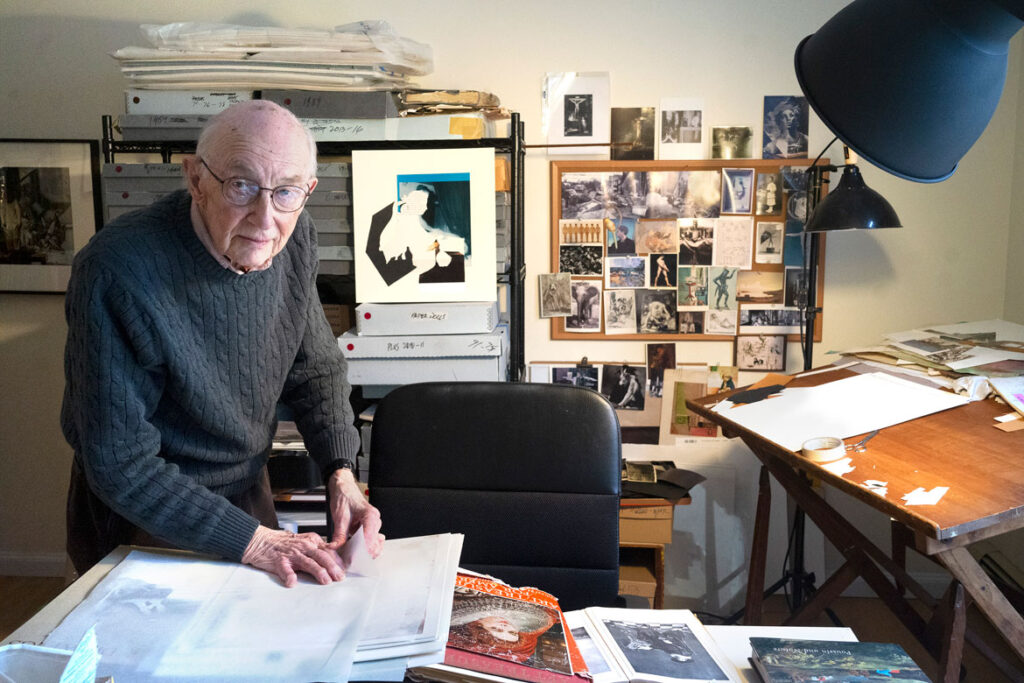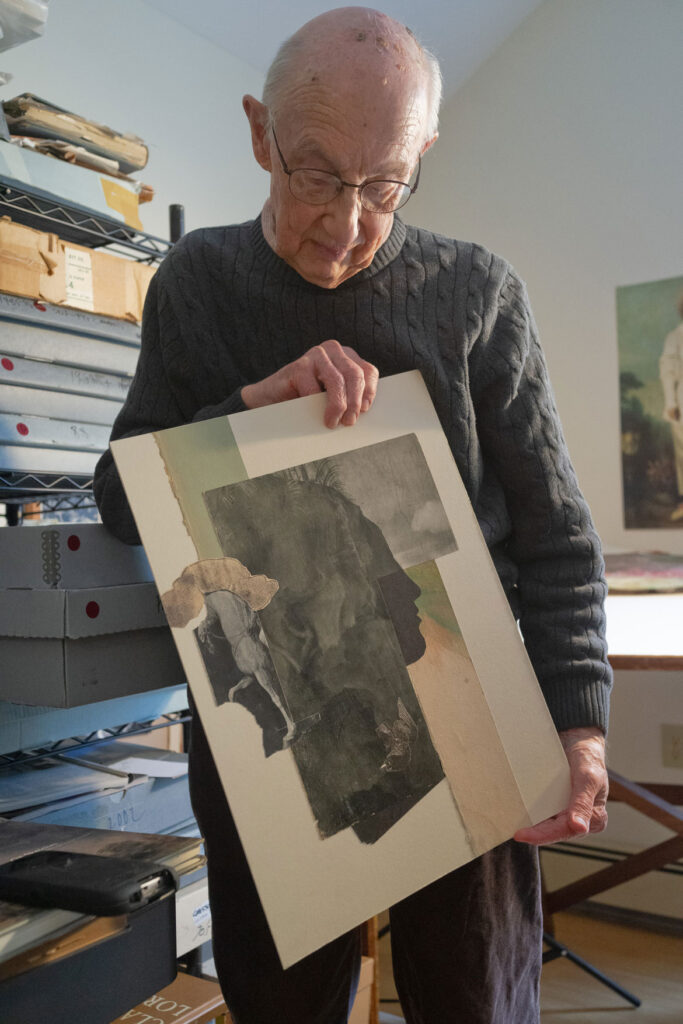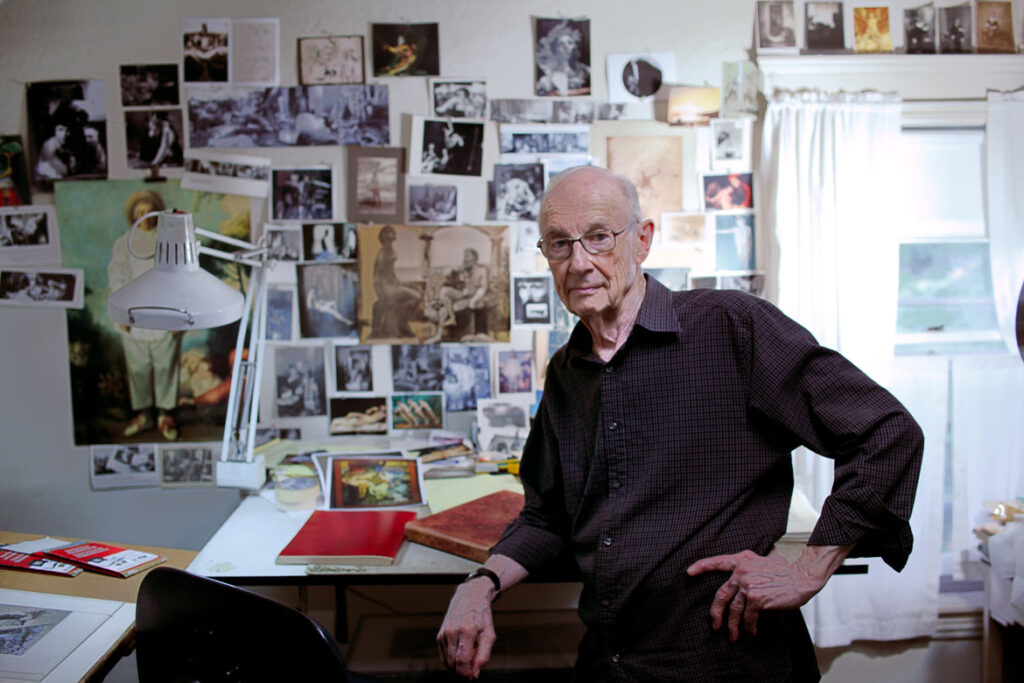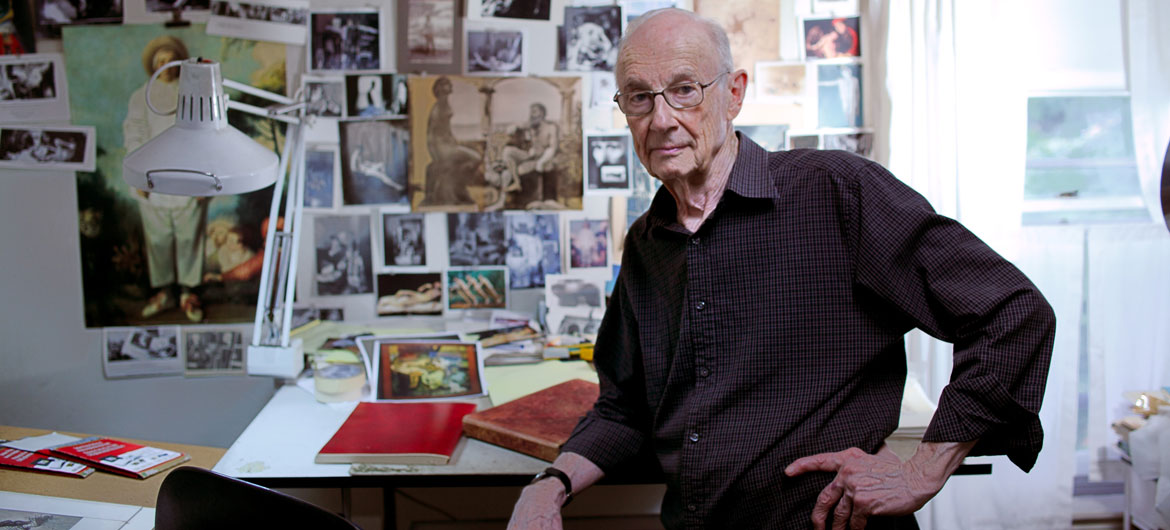John O’Reilly, the celebrated Worcester collage artist, died this morning, May 20, at age 91. His partner of 60 years, sculptor James Tellin, “was in the room with him, rubbing his feet when he realized he was gone,” says Howard Yezerski, who has exhibited O’Reilly’s art for decades.
O’Reilly won national attention when several artworks by the “obscure 65-year-old collagist from Boston” (in the words of New York Times critic Michael Kimmelman) were featured in the 1995 Whitney Biennial in New York.
“Most of the visual elements are lifted from art history, gay pornography and found vintage photographs, supplemented by photos taken by (and of) Mr. O’Reilly himself. The complex cutting and pasting, subtle and seamless, is entirely hand done, without digital assistance.” New York Times critic Holland Cotter reported in 2011.
Yezerkski recalls, “My little gallery represented him in a Whitney Biennial in 1995 that Klaus Kertess put together. The work could be beautiful and it could be outrageous. It was also charming, honest and fearless.”

O’Reilly grew up gay and Catholic in suburban New Jersey, where he was born in February 1930. Decades later, he would make art inspired by the years of World War II, when his father was away serving in the military and wreckage from torpedoed ships washed up on nearby beaches.
O’Reilly studied at Syracuse University and the School of the Art Institute of Chicago, before becoming a part-time art therapist at Worcester State Hospital for 27 years. And he made “small, intricate photo-collages in private for many years,” Cotter reported in 2011.
One of O’Reilly’s first collages, his 1965 “Self-Portrait,” mixed “Polaroid self-portraits with images from astronomy and Hieronymus Bosch. A large hand scrapes over moon craters, soil, and a woman’s body. Tiny male figures stand and sit on the last, as if it were a landscape; one of the breasts squirts a nebula into the cosmos,” Boston Globe critic Cate McQuaid wrote of a 2014 exhibition at the Worcester Art Museum.
O’Reilly combined images of West Coast modernist architecture with Poussin, Cezanne, Ingres, Titian, Vermeer, and other art historical references in collages during the 1970s. When these works were featured in a 1983 exhibition at the Addison Gallery of American Art in Andover, critic Robert Taylor wrote in The Boston Globe: “Perhaps the most engrossing work is a series of autobiographical images in which the quasi-nude artist appears in resonant contexts like the platinum prints of Walt Whitman by Thomas Eakins.” The collages “imply paradox, visual pun and the interactions of what we see and what we know.”

During the 1990s war became O’Reilly’s subject. “He always felt war was the greatest obscenity of human kind,” Yezerkski says. When the Boston galleries exhibited these collages featuring imagery of sex, religion and violence, Yezerski recalls putting up a sign up warning about the content—including a collage depicting Christ with someone’s finger up his bottom.
Yezerski remembers, “I swear to God I had a visit from a cop in plain clothes, it must have been a state cop. … Is this pornography or is it art?”
Of a 1998 group show at Boston’s Institute of Contemporary Art, Globe critic critic Christine Temin wrote, “The best photographs in the show are those of John O’Reilly, whose black and white montages star nude men in acrobatic high jinks against a vast, dark void that suggests outer space.”
When four-decade survey of O’Reilly’s art appeared at Yezerski Gallery in 2009, critic Sebastian Smee wrote in the Globe: “O’Reilly’s way with photomontage—his combination of intellectual wit and eroticism (in most cases homoeroticism)—is also intimately present and even conversational. We are invited into these images, which shimmer with art history quotations, frank avowals of desire, and playful meditations on the artist’s predicament.”
If this is the kind of coverage of arts, nature, cultures and activisms you appreciate, please support Wonderland by contributing to Wonderland on Patreon. And sign up for our free, (hopefully) weekly newsletter so that you don’t miss any of our reporting. (All content ©Greg Cook 2021 or the respective creators.)


